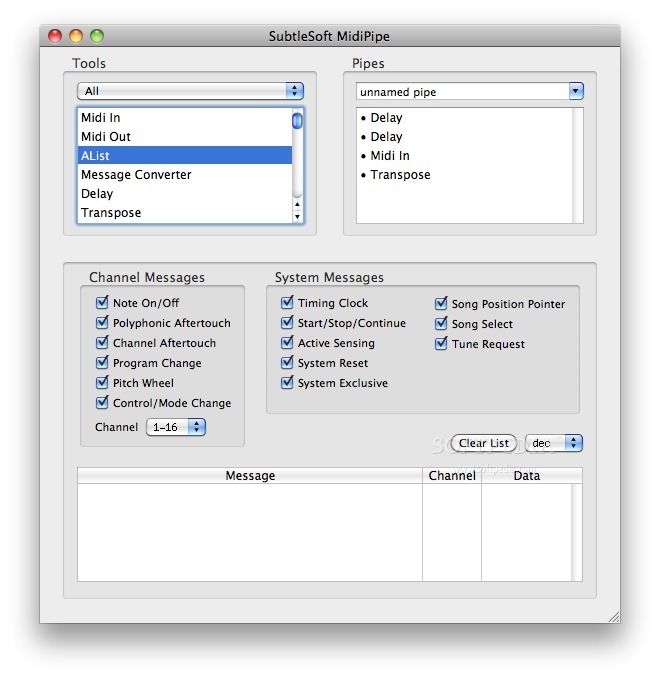Midipipe For Windows Download

More ways to shop: Visit an Apple Store, call 1-800-MY-APPLE, or find a reseller. Ford ids software help.
Sure, what with it being 2008 and all, “plug-in” to many people means audio processing. But what if you want an arpeggiator? Or something to harmonize incoming notes, or match them to scales?
Or well, just about anything else you can do with pitch and time with MIDI, from utilities to music effects? And what if your host’s built-in options are letting you down? The good news: you’ve got lots of options. The bad news: a lot are on Windows. We saw, a Mac/Windows utility for assigning QWERTY keyboards to MIDI input, earlier this week. But that’s led to some other discussions.
The includes a whole range of free MIDI plug-ins for Windows VST hosts. There’s already, a very nice, mature QWERTY keyboard (similar to Chirp, but a little simpler and functioning as a plug-in). In beta or “teaser” form are some other interesting utilities: a pattern-based arpeggiator (pictured, top), filter/router, chord generator, and eventually a Control Change-powered LFO you can drop anywhere you like. (I’d love to have that last one in Ableton Live, since I miss the readily-available LFOs found in tools like FL Studio.) Thanks to for the tip on this one. But ready to jump down the rabbit hole? (midiplugins.com) is an attempt to list, comprehensively, every MIDI plug-in in the universe of current software.
(Yikes!) Most are simple, free utilities, and most run free on Windows. You’ll also see a list of plug-ins found in hosts like Cakewalk’s SONAR. (Thanks, Eoin!) Why the PC bias? Unfortunately for Mac users, the PC has tended to have better support for this sort of thing.
Windows has not one but two formats for MIDI processing: the favored VST format from Steinberg has long supported MIDI, and DirectX has its own “mfx” format. (The latter is less popular, but you’ll see there are still a number of handy tools.) Mac audio developers would be more qualified than I am to describe the situation with Apple’s Audio Units format, but it appears in-line MIDI processing isn’t supported at all. (If I’m wrong, and it is, developers haven’t picked it up.) A was apparently added to AU for Leopard, but from the description it’s still designed for processing MIDI data for an audio plug-in, not for writing MIDI plug-ins, per se. Mac users do have one utility that makes up for this, however, and may be preferable to using plug-ins: the awesome, elegant MidiPipe, which runs independently from your host app and processes custom “pipes” of MIDI messages.
Windows users who prefer using a separate app to working with plug-ins (or want still more power), be sure to check out and. Oh, yeah, and on both Windows and x86 Linux, you can use (formerly Keynote), a free programming environment for MIDI, sometimes-CDM reader. Bottom line: you can do a ridiculous amount with MIDI data, regardless of your choice of platforms and tools.
I’m not helping. You just kicked your habit with audio software, and now you can fall down a spiraling addiction to MIDI software. Sim emu 6.01 configurator v2 1 free download.
Windows 10 Download
Dtdc pin code software download. Download and install the app and server and make sure to deinstall previous versions of midimux and audiomux. Once the server is installed and the mac has been restarted, a new icon will appear in the system tray. The context menu displays the current available and connected iOS devices and the status of the audio device. On Mac OSX 10.8+ you can load or unload the audiodevice by clicking load/unload audio device. Each status change requires an admin password entry.
You may quit the server by clicking quit – and restart it – whenever you need it – from the Applications folder. Connect iOS device and mac via usb cable Windows before installing studiomux make sure, that you have installed the the NET Framework 4.5 or higher and iTunes or alternatively, if you don't want to install full iTunes, please follow this guide 1. Download and install app and server once the server is installed, a new icon appears in the system tray. The vsts are not installed by default. Please right-click the studiomux-icon in the taskbar and select ‘Install 64-Bit VSTs’ or ‘Install 32-Bit VSTs’ depending on your current Windows version.